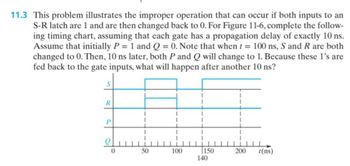11.3 This problem illustrates the improper operation that can occur if both inputs to an S-R latch are 1 and are then changed back to 0. For Figure 11-6, complete the follow- ing timing chart, assuming that each gate has a propagation delay of exactly 10 ns. Assume that initially P = 1 and Q = 0. Note that when t = 100 ns, S and R are both changed to 0. Then, 10 ns later, both P and Q will change to 1. Because these 1's are fed back to the gate inputs, what will happen after another 10 ns? S R P 0 50 100 150 140 200 t(ns)
11.3 This problem illustrates the improper operation that can occur if both inputs to an S-R latch are 1 and are then changed back to 0. For Figure 11-6, complete the follow- ing timing chart, assuming that each gate has a propagation delay of exactly 10 ns. Assume that initially P = 1 and Q = 0. Note that when t = 100 ns, S and R are both changed to 0. Then, 10 ns later, both P and Q will change to 1. Because these 1's are fed back to the gate inputs, what will happen after another 10 ns? S R P 0 50 100 150 140 200 t(ns)
Oh no! Our experts couldn't answer your question.
Don't worry! We won't leave you hanging. Plus, we're giving you back one question for the inconvenience.
Submit your question and receive a step-by-step explanation from our experts in as fast as 30 minutes.
You have no more questions left.
Message from our expert:
Our experts are unable to provide you with a solution at this time. Try rewording your question, and make sure to submit one question at a time. We've credited a question to your account.
Your Question:

Transcribed Image Text:11.3 This problem illustrates the improper operation that can occur if both inputs to an
S-R latch are 1 and are then changed back to 0. For Figure 11-6, complete the follow-
ing timing chart, assuming that each gate has a propagation delay of exactly 10 ns.
Assume that initially P = 1 and Q = 0. Note that when t = 100 ns, S and R are both
changed to 0. Then, 10 ns later, both P and Q will change to 1. Because these 1's are
fed back to the gate inputs, what will happen after another 10 ns?
S
R
P
0
50
100
150
140
200 t(ns)
Knowledge Booster
Learn more about
Need a deep-dive on the concept behind this application? Look no further. Learn more about this topic, computer-science and related others by exploring similar questions and additional content below.Recommended textbooks for you

Database System Concepts
Computer Science
ISBN:
9780078022159
Author:
Abraham Silberschatz Professor, Henry F. Korth, S. Sudarshan
Publisher:
McGraw-Hill Education

Starting Out with Python (4th Edition)
Computer Science
ISBN:
9780134444321
Author:
Tony Gaddis
Publisher:
PEARSON

Digital Fundamentals (11th Edition)
Computer Science
ISBN:
9780132737968
Author:
Thomas L. Floyd
Publisher:
PEARSON

Database System Concepts
Computer Science
ISBN:
9780078022159
Author:
Abraham Silberschatz Professor, Henry F. Korth, S. Sudarshan
Publisher:
McGraw-Hill Education

Starting Out with Python (4th Edition)
Computer Science
ISBN:
9780134444321
Author:
Tony Gaddis
Publisher:
PEARSON

Digital Fundamentals (11th Edition)
Computer Science
ISBN:
9780132737968
Author:
Thomas L. Floyd
Publisher:
PEARSON

C How to Program (8th Edition)
Computer Science
ISBN:
9780133976892
Author:
Paul J. Deitel, Harvey Deitel
Publisher:
PEARSON

Database Systems: Design, Implementation, & Manag…
Computer Science
ISBN:
9781337627900
Author:
Carlos Coronel, Steven Morris
Publisher:
Cengage Learning

Programmable Logic Controllers
Computer Science
ISBN:
9780073373843
Author:
Frank D. Petruzella
Publisher:
McGraw-Hill Education
